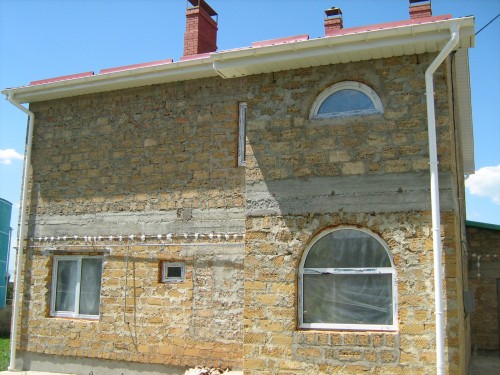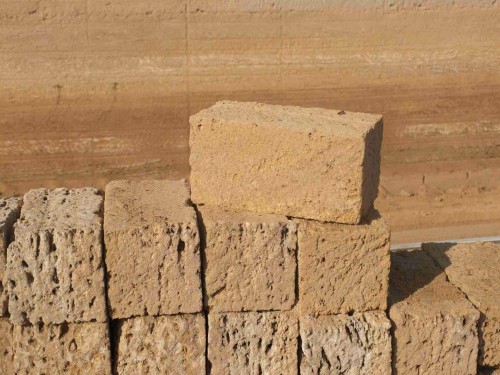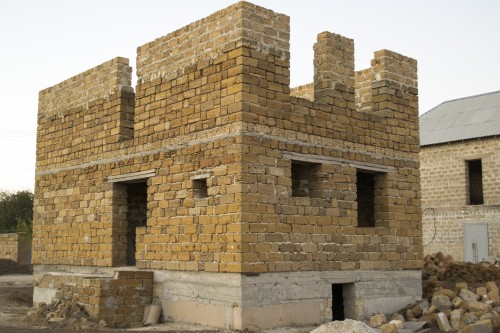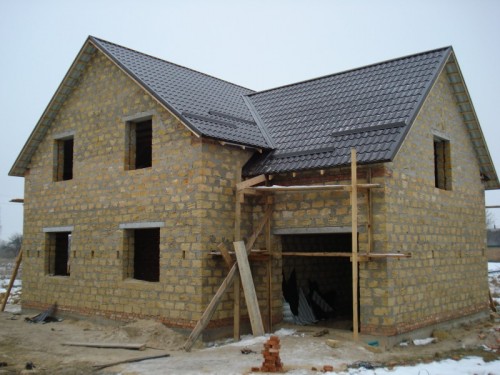
Stone riser. Building house construction Building materials
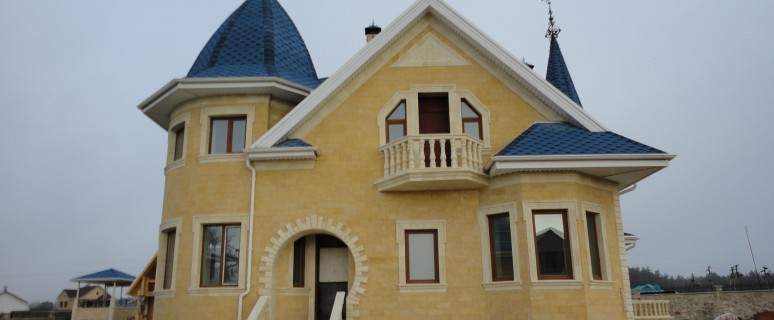
The search for the ideal building material continues constantly. Recently, many people prefer natural materials that nature created the sam. One of these is the shell stone.
Content
Scope of application
The sewer has an origin similar to marble and limestone. The only difference is smaller density. In essence, the material is a pressed shells of mollusks and is a porous stone that is easy to handle. Natural stone Carnish is represented by many colors, ranging from white and ending with light brown tones.
The scope of the sewer is very diverse. From the stone can be erected:
- carriers and attic walls;
- partitions in residential premises;
- outbuildings;
- fences and retaining structures;
- stair marches;
- parade inputs;
- various decorative elements (cornices, arches, curly window sills).
With the help of a seven, the inner and outer decoration of brick walls are produced. It is used in landscape design and as a cement mortar aggregate.
Materials can be embedded with steps made from concrete. Moreover, the price of such a decoration by a stone of the shelling is much lower than the use of another natural stone. The only thing is that it is forbidden to build a sewer - these are chimneys, stoves and fireplaces.
Properties of material
In addition to absolute ecology, the sewer is characterized by:
- low thermal conductivity;
- good sound insulation;
- high vapor permeability;
- non-susceptibility to corrosion and decay;
- fire safety.
Due to the porous structure of the material excess moisture out of the house through the wall, and after heavy rain soaked the walls dry quickly. For this reason, indoors is not recommended for sealed insulating and finishing materials. Without them in the house of the shell will be dry and comfortable.
Shell rock is the only natural material that is 100% resistant to radiation exposure. Stone does not react with the mixtures intended for construction and finishing works.
In buildings constructed of limestone, rodents do not take root. The material does not cause allergic reactions in people. A stone at the location of the interior of the rooms of the house will be enriched antibacterial salt and iodine.
For residential buildings, use coquina, which is marked by M10 to M35. To buy coquina stone, which has a maximum strength, one should pay attention to the appearance of the material. The noticeable pores, the stronger the stone.
The foundation for the house
For buildings of limestone must be addressed by pouring strong and solid foundation. Despite the presence of pores, different solid stone weight. The best option - to fill rubble concrete or reinforced concrete foundation.
Shell rock itself is not very suitable for the creation of the foundation, because it is a hygroscopic material. To qualitatively organize such a foundation need to spend too costly waterproofing.
There is a variant of the foundation device recrystallized shell limestone, which is characterized by high density (up to 100 kg / cm³) and moisture resistance. But this material has a significant disadvantage - it is almost impossible to cut.
Another mandatory requirement to create the foundation. At the base of the houses, built of limestone, laid a high base. Its size should be greater than 40 cm. The required quality is conducted horizontal waterproofing of the foundation.
masonry work
For the construction of houses made of limestone can be used:
- mortar (. 1 h lime and 3 parts of sand.);
- cement mortar (1 part cement and four parts sand..);
- cement mortar (1 hour. The cement, 1 hr., and 4 hr of lime. sand).
Masonry walls can be done in three ways:
- single-row;
- two-row;
- multilane.
The first technology is used very rarely. When erecting the walls it involves stacking blocks in a half-brick.
The most common is the two-row and multi-row laying of material, which are carried out with alternation of longitudinal and transverse rows. The double-row technology provides constant alternation of transverse and longitudinal rows, and a multi-row method - laying 3-5 longitudinal and 1-2 transverse rows.
Regardless of the method of masonry wall, special attention is paid to filling vertical seams. Often the solution is poured in them straight from above. The thickness of the horizontal seams should not exceed 1.5 cm, vertical joints - 2 cm.
For the jumper device above the door and window openings, brick or concrete is used. Steel fittings and formwork are used to create a concrete jumper.
The last row of laid blocks is poured by a concrete tie. Its purpose is the leveling of the top of the wall, since in most cases the bike blocks have different heights. After drying the screed, the reinforcing belt is created.
The best option is the reinforcing belt of concrete, covered throughout the perimeter of the house. A rods of up to 1 cm or a welded grid are used as the reinforcement. The height of the reinforcing layer is made up at 15-20 cm.
To reduce heat losses through a concrete belt, the outer side of the walls is insulated with the help of extruded polystyrene foam or by laying 1-2 longitudinal rows of bricks.
Roofing and finishing work
The house of the shell can be covered with the same roofing material as the roofs of the buildings, which are erected from aerated concrete, foam blocks and bricks. The roof can acquire completely different outlines and configurations.
The only difference in the roof of the house of the sewer is the presence of a longer ovel of the roof. Its size should exceed 30 cm. The most optimal option will be the ott, the length of which is 60-70 cm.
To finish the outer walls built from the sewer, you can use:
- brick;
- cement mortar;
- decorative plaster.
Plastering is carried out using a grid fixed to the wall. The inner plastering of the surface implies plausing with a masonry solution, followed by a facing of the finish coating.
Thermal insulation works are carried out using materials that are characterized by maximum parpropuscular ability. The most optimal option is the use of mineral wool. For insulation of outer walls, use extruded polystyrene foam.
Video about the nuances of the construction of a sequishman's house:





